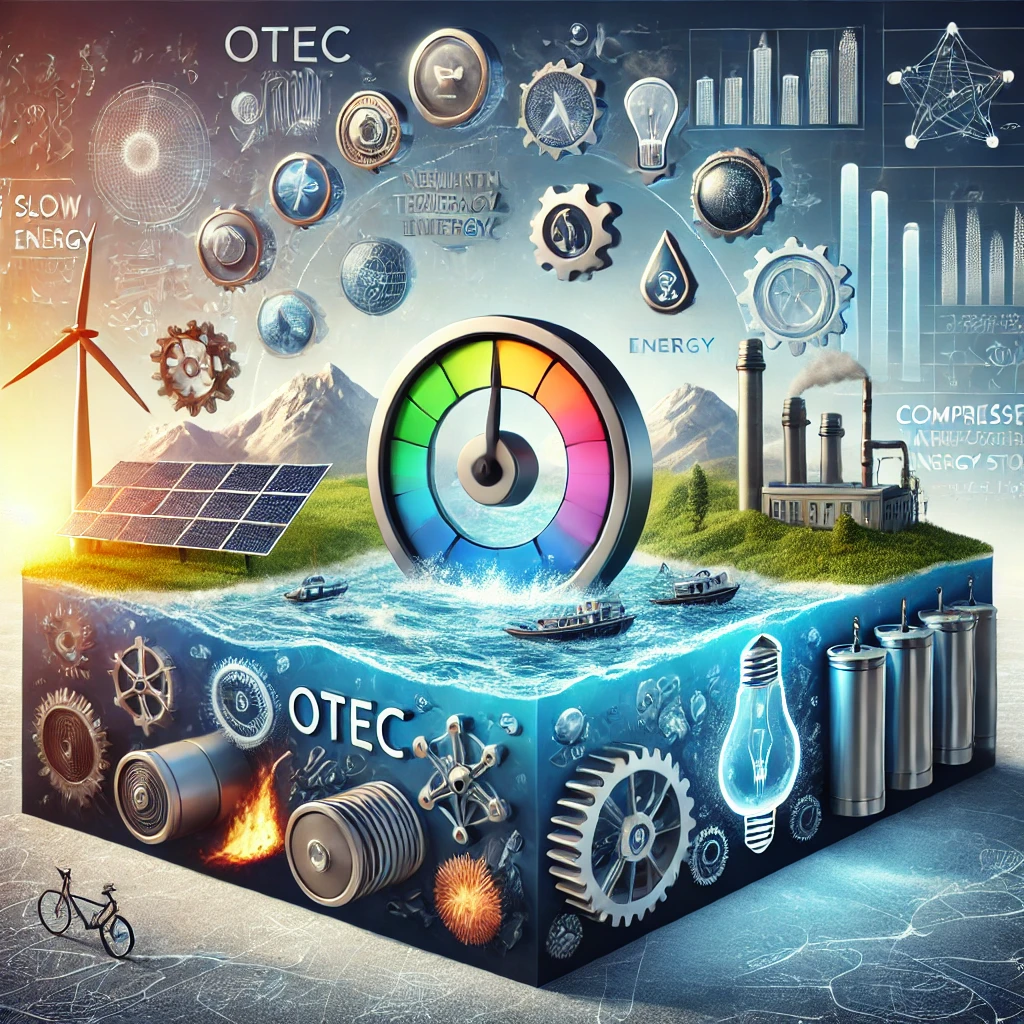In the quest for sustainable energy solutions, the utilization of natural gradients and rates of change, such as temperature and pressure differences, presents a promising avenue for generating electricity. This approach leverages physical phenomena in unique environments, such as under the ocean or deep within the Earth’s crust, to produce renewable energy. This article explores how gradients can be harnessed to generate electricity, the role of slow-speed turbines in renewable energy, and the practical implications of these technologies in power generation and storage.
Utilizing Gradients for Electricity Generation
Temperature Gradients: Ocean Thermal Energy Conversion (OTEC)
One of the most fascinating applications of temperature gradients is Ocean Thermal Energy Conversion (OTEC). This technology exploits the temperature difference between warm surface water and cold deep water in the ocean to generate electricity.
- The Process: Warm surface seawater is used to vaporize a working fluid with a low boiling point, such as ammonia. The vapor produced drives a turbine connected to a generator, producing electricity. The vapor is then condensed using cold seawater pumped from deeper ocean layers, and the cycle repeats.
- Advantages: OTEC provides a continuous and reliable source of energy, unlike solar and wind power which are intermittent. It also offers additional benefits such as desalinated water and air conditioning.
Pressure Gradients: Geothermal Energy
Geothermal energy harnesses the heat stored within the Earth, typically from natural underground reservoirs of hot water or steam, to generate electricity.
- The Process: Wells are drilled into geothermal reservoirs to bring hot water or steam to the surface. The steam drives turbines, generating electricity. The cooled water is then reinjected into the reservoir to sustain the pressure and heat for continuous power generation.
- Advantages: Geothermal energy is a stable and reliable source of power with low greenhouse gas emissions. It can provide base-load power, which is crucial for grid stability.
Compression of Air: Compressed Air Energy Storage (CAES)
CAES systems use excess electricity from renewable sources to compress air, which is stored in underground caverns. When electricity demand is high, the compressed air is released, heated, and expanded to drive turbines and generate electricity.
- The Process: Air is compressed using surplus electricity and stored under high pressure. During peak demand, the compressed air is released, mixed with natural gas or heated using renewable sources, and expanded through a turbine to generate electricity.
- Advantages: CAES can store large amounts of energy for long periods, providing a buffer against the intermittency of renewable energy sources.
The Role of Slow-Speed Turbines
In traditional fossil fuel power plants, turbines are designed to operate at constant speeds (50Hz or 60Hz) to ensure a stable electricity supply. However, renewable energy sources like wind and ocean currents do not always provide a constant input, necessitating the use of slow-speed turbines.
Variable Speed Operation
- Adaptability: Slow-speed turbines can operate efficiently at varying speeds, making them ideal for renewable energy applications where the power input fluctuates.
- Efficiency: These turbines are designed to maximize energy capture from variable inputs, ensuring higher overall efficiency compared to traditional fixed-speed turbines.
Direct Drive Systems
- Simplified Mechanism: Direct drive turbines eliminate the need for gearboxes, reducing mechanical losses and maintenance requirements.
- Increased Reliability: With fewer moving parts, direct drive turbines offer greater reliability and a longer lifespan, which is particularly beneficial in harsh marine or geothermal environments.

Practical Considerations for Power Generation and Storage
Managing Intermittency
Renewable energy sources are inherently intermittent. Effective energy storage solutions, such as CAES and advanced battery systems, are essential for smoothing out supply fluctuations and ensuring a stable power supply.
- Grid Integration: Advanced grid management systems and smart grids can help integrate renewable energy more effectively, balancing supply and demand in real-time.
- Demand Response: Implementing demand response strategies, where consumers adjust their energy usage based on supply availability, can further enhance grid stability.
Enhancing Efficiency
Improving the efficiency of energy conversion and storage technologies is critical for maximizing the benefits of renewable energy.
- Heat Recovery: In geothermal and CAES systems, capturing and utilizing waste heat can significantly boost overall efficiency.
- Material Innovations: Developing advanced materials that can withstand extreme temperatures and pressures can enhance the performance and durability of turbines and other components.
Economic Viability
For renewable energy technologies to be widely adopted, they must be economically viable. This involves reducing upfront costs, improving efficiency, and ensuring competitive energy prices.
- Policy Support: Government policies and incentives, such as tax credits and subsidies, can help lower the financial barriers to deploying advanced renewable energy technologies.
- Research and Development: Continued investment in R&D is essential for driving innovation and bringing down costs over time.
Conclusion
The utilization of gradients and rates of change, such as temperature and pressure differences, offers a promising pathway for generating renewable energy. Technologies like OTEC, geothermal energy, and CAES can harness these natural phenomena to produce electricity sustainably. Slow-speed turbines play a crucial role in adapting to the variable nature of renewable energy inputs, enhancing efficiency and reliability. As we advance in our understanding and application of these technologies, it is essential to focus on practical solutions for power generation and storage, ensuring a stable and economically viable energy future. By leveraging these innovative approaches, we can make significant strides toward a more sustainable and resilient energy system.
